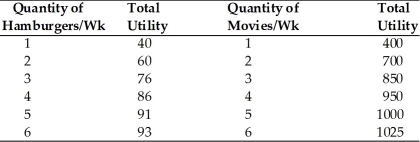Multiple Choice

-Refer to the above table. Suppose the price of a hamburger is $2, the price of a movie is $5, and the income of the consumer is $29. How many hamburgers and movies will this consumer buy to be at an optimum?
A) 1 hamburger and 5 movies
B) 6 hamburgers and 3 movies
C) 4 hamburgers and 4 movies
D) 2 hamburgers and 5 movies
Correct Answer:

Verified
Correct Answer:
Verified
Q212: The diamond-water paradox illustrates the idea that
Q213: The change in satisfaction derived when an
Q214: John is currently spending all of his
Q215: The price of hamburgers is $2 and
Q216: <img src="https://d2lvgg3v3hfg70.cloudfront.net/TB5018/.jpg" alt=" -Refer to the
Q218: A consumer's optimum is found when<br>A) the
Q219: The price of a hotdog is $1,
Q220: <img src="https://d2lvgg3v3hfg70.cloudfront.net/TB5018/.jpg" alt=" -The price of
Q221: How does an increase in the price
Q222: If marginal utility is negative<br>A) total utility